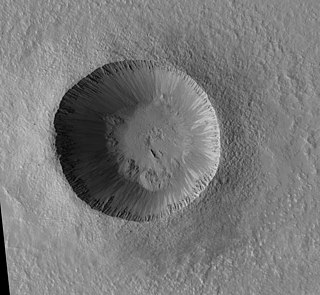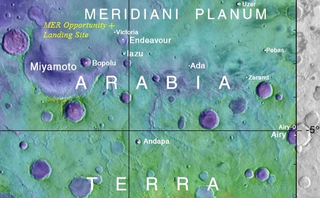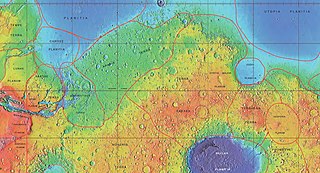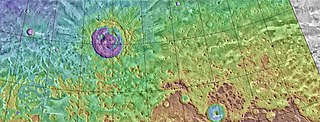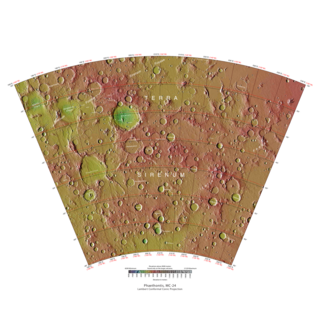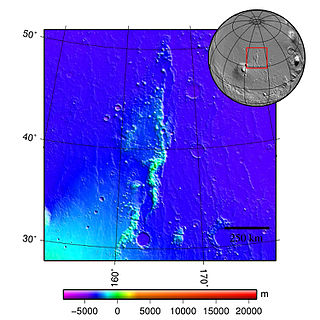The landscape polewards of around 30 degrees latitude on Mars has a distinctively different appearance to that nearer the equator, and is said to have undergone terrain softening. Softened terrain lacks the sharp ridge crests seen near the equator, and is instead smoothly rounded. This rounding is thought to be caused by high concentrations of water ice in soils. The term was coined in 1986 by Steve Squyres and Michael Carr from examining imagery from the Viking missions to Mars.

Mars is the fourth planet from the Sun and the second-smallest planet in the Solar System after Mercury. In English, Mars carries a name of the Roman god of war, and is often referred to as the "Red Planet" because the iron oxide prevalent on its surface gives it a reddish appearance that is distinctive among the astronomical bodies visible to the naked eye. Mars is a terrestrial planet with a thin atmosphere, having surface features reminiscent both of the impact craters of the Moon and the valleys, deserts, and polar ice caps of Earth.

Steven Weldon Squyres is the James A. Weeks Professor of Physical Sciences at Cornell University in Ithaca, New York. His research area is in planetary sciences, with a focus on large solid bodies in the Solar System such as the terrestrial planets and the moons of the Jovian planets. Squyres was the principal investigator of the Mars Exploration Rover Mission (MER). He is the recipient of the 2004 Carl Sagan Memorial Award and the 2009 Carl Sagan Medal for Excellence in Communication in Planetary Science. On October 28, 2010, Squyres received the 2010 Mines Medal for his achievements as a researcher and professor. He is the brother of Academy Award-nominated film editor Tim Squyres.

The Viking program consisted of a pair of American space probes sent to Mars, Viking 1 and Viking 2. Each spacecraft was composed of two main parts: an orbiter designed to photograph the surface of Mars from orbit, and a lander designed to study the planet from the surface. The orbiters also served as communication relays for the landers once they touched down.
Contents
Below 30 degrees of latitude, impact craters have steep walls; well-defined, sharp rims; and flat or smoothly bowl-shaped floors. Ridges on intercrater plains come to similarly well-defined, pointed crests. However, above this latitude, these same features appear very different. The crests seen on ridges and crater rims appear strongly rounded and much more poorly defined. The relief (height) of features is somewhat reduced. Small craters are noticeably less common. In other words, terrain which elsewhere looked sharp here looks "soft". [1] [2] [3] This texture has also been described as "smooth", or "rolling". [4] Softened craters are also commonly infilled with concentric patterns on their floors. [2]
A concentric crater fill is a landform where the floor of a crater is mostly covered with many parallel ridges. It is common in the mid-latitudes of Mars, and is widely believed to be caused by glacial movement. Areas on Mars called Deuteronilus Mensae and Protonilus Mensae contain many examples of concentric crater fill.
On Earth, diffusive creep of soils is associated with rounded hillslopes. [5] [6] Squyres and Carr thus attributed the softened texture to accelerated viscous creep in shallow soils near the surface, and went on to associate this accelerated creep with the presence of ground ice at these latitudes. [1] This conclusion has been largely borne out by subsequent research. [2] [7] In the late 1980s some attempts were made to link terrain softening with dust and aeolian processes, [8] [9] though this hypothesis has largely been superseded by more recent observations. [2]

Diffusion is net movement of anything from a region of higher concentration to a region of lower concentration. Diffusion is driven by a gradient in concentration.

Downhill creep, also known as soil creep or commonly just creep, is the slow downward progression of rock and soil down a low grade slope; it can also refer to slow deformation of such materials as a result of prolonged pressure and stress. Creep may appear to an observer to be continuous, but it really is the sum of numerous minute, discrete movements of slope material caused by the force of gravity. Friction, being the primary force to resist gravity, is produced when one body of material slides past another offering a mechanical resistance between the two which acts to hold objects in place. As slope on a hill increases, the gravitational force that is perpendicular to the slope decreases and results in less friction between the material that could cause the slope to slide.

Aeolian processes, also spelled eolian or æolian, pertain to wind activity in the study of geology and weather and specifically to the wind's ability to shape the surface of the Earth. Winds may erode, transport, and deposit materials and are effective agents in regions with sparse vegetation, a lack of soil moisture and a large supply of unconsolidated sediments. Although water is a much more powerful eroding force than wind, aeolian processes are important in arid environments such as deserts.
Terrain softening is one of a suite of features seen in the midlatitudes of Mars—also including lobate debris aprons, lineated valley fill, concentric crater fill, latitude dependent mantle, patterned ground, viscous flow features, arcuate ridges, recurring slope lineae, and gullies—whose form and distribution strongly suggest the abundance of ice at the surface. [2]

Lobate debris aprons (LDAs) are geological features on Mars, first seen by the Viking Orbiters, consisting of piles of rock debris below cliffs. These features have a convex topography and a gentle slope from cliffs or escarpments, which suggest flow away from the steep source cliff. In addition, lobate debris aprons can show surface lineations as do rock glaciers on the Earth.

Lineated valley fill (LVF), also called lineated floor deposit, is a feature of the floors of some channels on Mars, exhibiting ridges and grooves that seem to flow around obstacles. Shadow measurements show that at least some of the ridges are several metres high. LVF is believed to be ice-rich. Hundreds of metres of ice probably lie protected in LVF under a thin layer of debris. The debris consists of wind-borne dust, material from alcove walls, and lag material remaining after ice sublimated from a rock-ice mixture. Some glaciers on Earth show similar ridges. High-resolution pictures taken with HiRISE reveal that some of the surfaces of lineated valley fill are covered with strange patterns called closed-cell and open-cell brain terrain. The terrain resembles a human brain. It is believed to be caused by cracks in the surface accumulating dust and other debris, together with ice sublimating from some of the surfaces. The cracks are the result stress from gravity and seasonal heating and cooling. This same type of surface is present on Lobate debris aprons and Concentric crater fill so all three are believed to be related.

Patterned ground is the distinct and often symmetrical natural pattern of geometric shapes formed by ground material in periglacial regions. Typically found in remote regions of the Arctic, Antarctica, and the Australian outback but also found anywhere that freezing and thawing of soil alternate; patterned ground has also been observed on Mars. The geometric shapes and patterns associated with patterned ground are often mistaken as artistic human creations. The mechanism of the formation of patterned ground had long puzzled scientists but the introduction of computer-generated geological models in the past 20 years has allowed scientists to relate it to frost heaving, the expansion that occurs when wet, fine-grained, and porous soils freeze.



